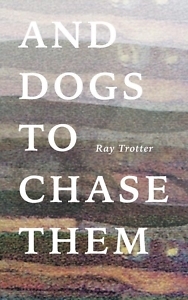Chasing Tales
Ray Trotter’s short story collection of Southern gems shines
Ray Trotter assembles a stylized, bite-sized, pure personality of a debut short story collection, And Dogs to Chase Them, exploring the quirks and nuances of rural Southern living. Trotter, whose bio boasts professions such as “railroad gandy dancer and bum down in Mexico,” lets his unique voice shine through. Many of the stories featured in the collection are small; some, such as “Fourteen but Counting” and “Do Not Call,” likely count as flash fiction. Others cover a dozen or so pages, but all contain quirky characters and a persistent, humorous undercurrent.
 “Fourteen but Counting” is composed of just two long sentences, and the first line serves as a perfect taste of Trotter’s unique style:
“Fourteen but Counting” is composed of just two long sentences, and the first line serves as a perfect taste of Trotter’s unique style:
At the recommendation of Juvenile Judge Harvey Pitts (of Mayo County, Georgia), at the special request from Mrs. Holcomb (Blackstock Middle principal), at the pleading of his single mother, the Scouts had recruited “Big” Wallace, elected him to Order of the Arrow, helped him with his reading, taught him skills of the Native American.
The rambling, roundabout sentence structure encapsulates the long-winded way of talking practiced by many throughout the South. The gossipy tone and the humorous undercurrent also help shroud the story in tall tale-esque lore reminiscent of some of the best standup storytellers. Trotter’s writing style is idiosyncratic — and perhaps even jarring to some readers — yet the tone and characters and the roundabout delivery effectively convey the diction of rural Tennessee, particularly of native East Tennesseans. Trotter, who grew up in Tellico Plains, knows the end of a story isn’t the exciting part. What’s exciting is the how — how we get to the final result.
Stories such as “Convergence,” which describes a car wreck by focusing on the before and the after rather than the shock and gory details of the wreck itself, encapsulate the way Southerners tell a story by talking around the story, never giving the details in chronological order, hopping from image to image, idea to idea, in an almost stream-of-consciousness delivery.
Admittedly, Trotter’s style is not for everyone. Some may find it too scattered. Trotter doesn’t seem to be one for setting a scene. Instead, we are simply in the scene, immediately a spectator to the action — and, more often than not, the action is something questionable or dangerous.
For example, in “Quiet Neighbors,” a story about a black Labrador named Satan, Trotter uses dialogue to show his character’s attitudes, motives, and hidden (or not so hidden) prejudices. When Satan is shot with birdshot by a neighbor for coming after her cat, the dog’s owner, Terry, tries to get the woman to pay for Satan’s vet bill. We are given insight into other townsfolks’ thoughts on the issue when the unnamed narrator engages in gossip with a woman named Edith at a café. Edith says, “Him and that dog, they just like brothers. … And you know what that makes him, don’t you?” She continues, “If he’s the brother of a dog then that ought to tell you something about the kind of mama.”
And Dogs to Chase Them offers an honest, uncut glimpse into the lives of Southern people in North Georgia and East Tennessee. These tall tales are sure to elicit a few chuckles and perhaps even a belly laugh or two from readers.

Abby N. Lewis is from Dandridge, TN. She is the author of the poetry collection Reticent, the chapbook This Fluid Journey, and the newly released chapbook Palm Up, Fingers Curled from Plan B Press.


